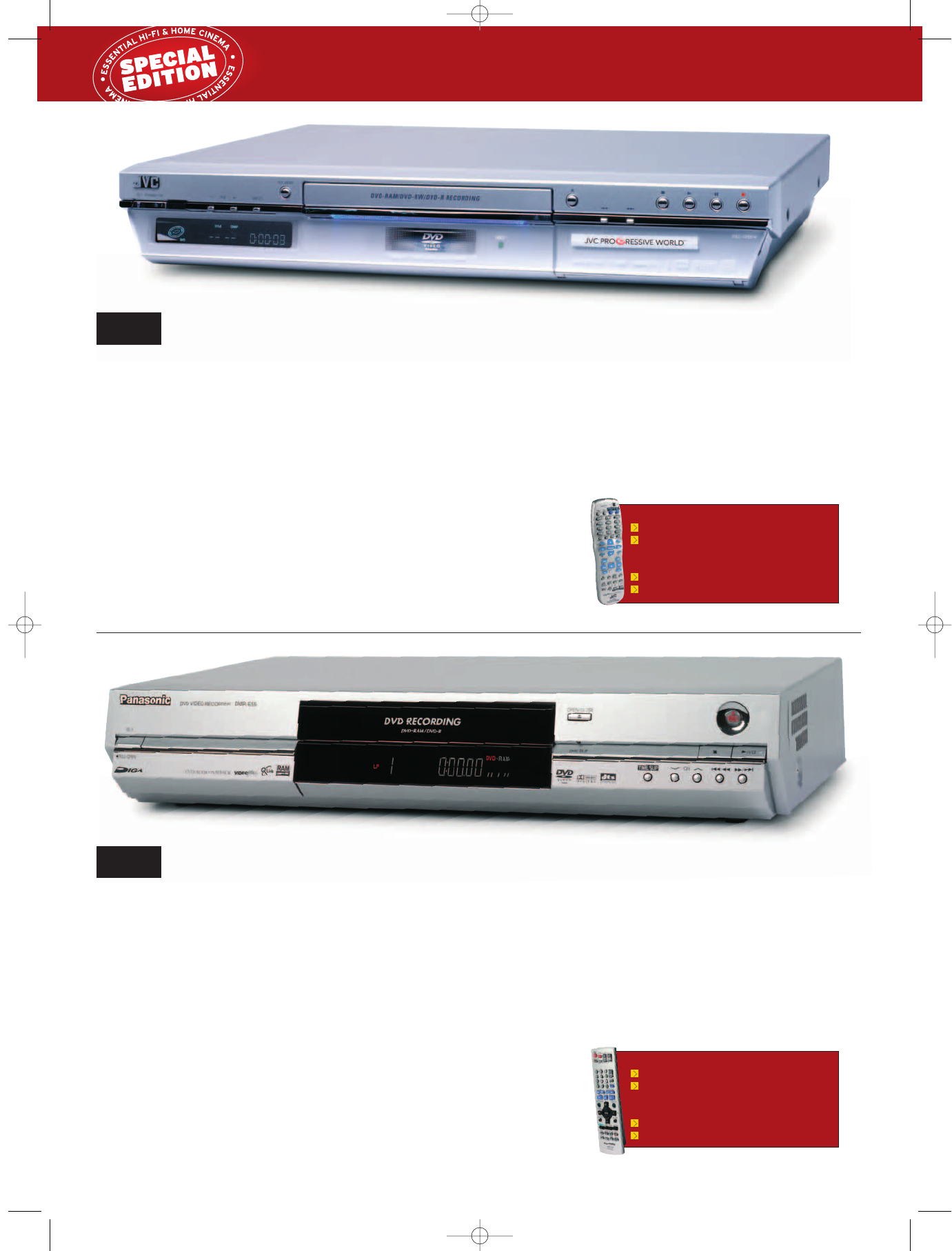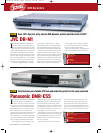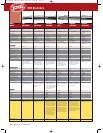
56 ESSENTIAL HI-FI & HOME CINEMA
Does JVC’s fine first entry into the DVD Recorder market mark the death of VHS?
£400
JVC DR-M1
I
N ADMITTING DEFEAT IN THE BATTLE TO
keep its invention, the video cassette, alive, JVC
has done the DVD Recorder market a big favour.
Where we do have a few gripes with the UK’s first
combined -RW and RAM recorder is its connections,
which include a RGB enabled Scart and separate S-
Video and stereo audio outputs. However, the second
Scart at the back of the unit, which connects set-top
boxes, cannot handle RGB sources – it will only accept
composite or S-Video sources. An i.Link terminal on
front panel allows digital dubbing from camcorders.
Its ‘living memory playback’ feature – watching a
recording while it’s still being made – is unique to
RAM compatible machines or those with hard drives
(and some DVD-RW machines). Recordings can be
made onto almost universally accepted DVD-R discs.
DVD-RW disks can be formatted in video-mode or
VR-mode. The latter allows free editing of contents
but the former is more widely compatible. That’s made
up for by satellite control (only with Sky digiboxes)
and the great ‘free rate’ (FR) recording mode, which
calculates time left on the disc in various recording
modes. This means you can chop and change between
bitrates on one (recordable or rewritable) disc.
Picture quality in XP and SP mode recordings is
clear, while the DR-MI’s progressive scan playback
works with recordings and PAL software.
With a such a low street price, JVC’s DR-M1 is only
a hard drive and a RGB input away from perfection.
Great features and a familiar VCR look and make this perfect for the newly converted
£300
Panasonic DMR-E55
I
T MAY BE AT THE LOW END OF PANASONIC’S
DIGA range, but what the DMR-E55 lacks
(hard drive, DV input) it makes up for in great
picture, sound and a myriad of recording functions.
That’s largely down to its compatibility with DVD-
RAM and DVD-R formats – but be aware that DVD-
RW discs cannot be used for recording. Its four
recording modes, XP, SP, LP and EP, range from one to
eight hrs of recording time. Picture quality on XP
mode is outstanding – as it is with pre-recorded DVDs
– while the more flexible SP mode is excellent. Other
modes are still better quality than VCR recordings.
Timer recordings can be made manually or with
VideoPlus, and there is also a PDC facility. The DVD-
RAM format offers extensive editing and is perfect
for daily recording and deleting. It also enables
‘chasing playback’, allowing you to watch the start of
a recording while it continues to record, as well as
‘time slip’, which means the last 30 secs of live TV
can be replayed – a boon for sports fans.
Playback functions include Direct Navigator, which
displays full-motion thumbnails of all recordings on a
disc, while Playback NR reduces picture noise and
Virtual Surround Sound mode does what it says –
with only two speakers.
Expansive connectivity comprises component
video output for PAL and NSTC progressive scan,
RGB Scart input and output, S-video support, an
optical digital audio out and front panel AV inputs
for connecting a camcorder. Missing features, like a
memory card slot, i.Link digital video connection and
hard drive can be found on other Panasonic models.
What’s good
Satellite control
Prog scan
What’s bad
No RGB input
Satellite control won’t work with Freeview or Sky+
What’s good
Versatility of DVD-RAM recording
Attractive design
What’s bad
DVD-RW recordings would have been useful
No DV input
DVD Recorders
039 EHC 08 DVD REC G.Test 21/9/04 5:31 PM Page 56






